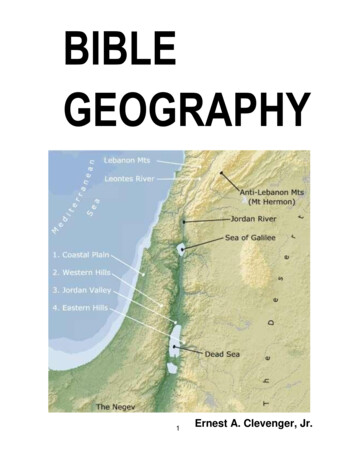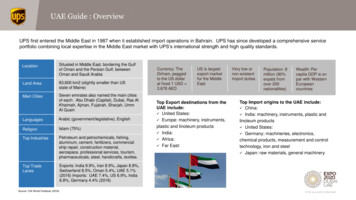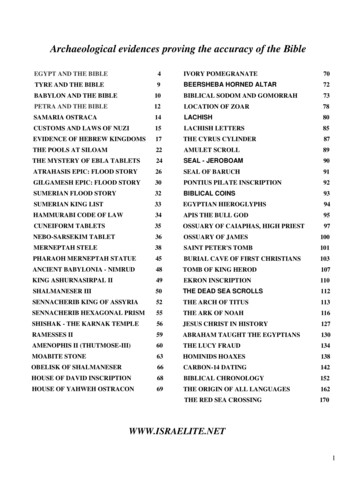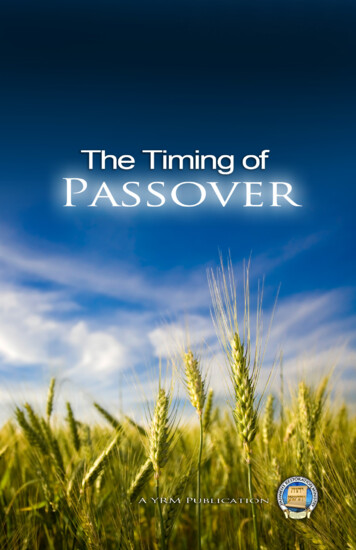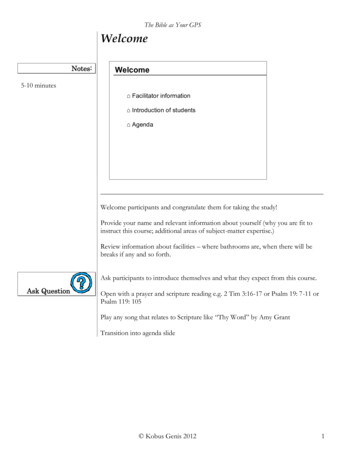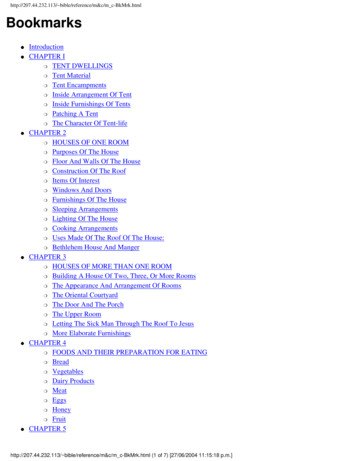
Transcription
http://207.44.232.113/ bible/reference/m&c/m c-BkMrk.htmlBookmarks IntroductionCHAPTER I TENT DWELLINGS Tent Material Tent Encampments Inside Arrangement Of Tent Inside Furnishings Of Tents Patching A Tent The Character Of Tent-lifeCHAPTER 2 HOUSES OF ONE ROOM Purposes Of The House Floor And Walls Of The House Construction Of The Roof Items Of Interest Windows And Doors Furnishings Of The House Sleeping Arrangements Lighting Of The House Cooking Arrangements Uses Made Of The Roof Of The House: Bethlehem House And MangerCHAPTER 3 HOUSES OF MORE THAN ONE ROOM Building A House Of Two, Three, Or More Rooms The Appearance And Arrangement Of Rooms The Oriental Courtyard The Door And The Porch The Upper Room Letting The Sick Man Through The Roof To Jesus More Elaborate FurnishingsCHAPTER 4 FOODS AND THEIR PREPARATION FOR EATING Bread Vegetables Dairy Products Meat Eggs Honey FruitCHAPTER 5http://207.44.232.113/ bible/reference/m&c/m c-BkMrk.html (1 of 7) [27/06/2004 11:15:18 p.m.]
http://207.44.232.113/ bible/reference/m&c/m c-BkMrk.htmlCUSTOMS AT MEALTIME Washing Of Hands Before Eating Position While Eating Use Of Table, Chairs, And Dishes Saying Grace At Meals Use Of Hand Instead Of Knife, Fork, Or Spoon Washing After The MealCHAPTER 6 SPECIAL SUPPERS AND BANQUETS Banquet Invitations "compelling" Guest To Attend Why Exclusion From A Feast Was Considered To Be So Terrible Posture While Eating At Feasts Places Of Honor At The Table Food And Entertainment At Banquets Dipping Into The Dish And Giving The SopCHAPTER 7 THE SACRED DUTY OF HOSPITALITY Eating Alone Disliked Kinds Of Guests Provision Made For Guest Customs When A Guest Enters A Home Caring For A Guest After Entrance Protecting A Guest The Abuse Of Hospitality Renewing A Broken CovenantCHAPTER 8 DAILY PROGRAM OF ACTIVITIES Early Rising Grinding Of The Grain By The Women Time Of Meals Weaving Cloth And Making Clothes Washing Clothes Caring For The Goats By The Girls The Midday Siesta Daily Conversation Going Of The Women For Water The Departure Of A GuestCHAPTER 9 DRESS AND ORNAMENTATION The Inner Garment-tunic Or Shirt The Outer Tunic Or Robe The Girdle The Outer Garment, Or Mantle http://207.44.232.113/ bible/reference/m&c/m c-BkMrk.html (2 of 7) [27/06/2004 11:15:18 p.m.]
http://207.44.232.113/ bible/reference/m&c/m c-BkMrk.htmlHeaddress Sandals The Difference Between Women's Dress And Men's Ornamentation Special Dress Of The Pharisees The Dress Of ChristCHAPTER 10 PARENTAL POSITION IN THE HOME Position Of The Father Position Of The MotherCHAPTER 11 BIRTH AND CARE OF CHILDREN Desire Of Jewish Women For Children Preference For Boy Babies Care Of Infant Child Jewish Rites And Offerings At Birth Of A Child Naming Of Children Duty Of Parents In Training Of ChildrenCHAPTER 12 EDUCATION OF YOUTH Schools At Ur When Abraham Was A Boy Schools In Egypt When Moses Was A Young Man Education Under The Law Of Moses The Schools Of The Prophets The Synagogue Schools When Jesus Was A Boy The Rabbinical School Of Paul's Day The Roman Schools Of The First CenturyCHAPTER 13 RELIGION IN THE HOME The Father As Priest In Patriarchal Times Religious Education Under The Law Family Pilgrimages To The Sanctuary The Bible In The Jewish Home Of Christ's Time Entertaining Fellow-believers In New Testament Times Christian Gatherings In The HomeCHAPTER 14 MARRIAGE CUSTOMS Polygamy In Old Testament Times Divorce In Old Testament Times Choice Of A Wife The Parents' Prerogative Conducting Negotiations To Secure A Wife The Marriage Dowry The Betrothal The Apparel Of Groom And Bride http://207.44.232.113/ bible/reference/m&c/m c-BkMrk.html (3 of 7) [27/06/2004 11:15:18 p.m.]
http://207.44.232.113/ bible/reference/m&c/m c-BkMrk.htmlGoing Of The Groom To Get The Bride The Wedding Procession Arrival At The House Of The Bridegroom The Wedding FeastCHAPTER 15 SOME SPECIAL EVENTS OF DOMESTIC FESTIVITY Dedication Of A Newly Built House Weaning Of A Child Harvest Home Sheep-shearingCHAPTER 16 SICKNESS IN BIBLE LANDS Old Testament Teaching On Health And Sickness What Old Testament Jews Did In Time Of Sickness Jewish Attitude Toward Sickness In Christ's Time Prevalence Of Sickness Expectation Of Supernatural PowerCHAPTER 17 DEATH IN ORIENTAL LANDS The Death Wail Lamentation Expressions Of Sorrow And Comfort Preparation Of The Body For Burial Eastern Funerals Biblical Expressions Of Oriental MourningCHAPTER 18 SHEPHERD LIFE; THE CARE OF SHEEP AND GOATS Sheep In The Land Of Israel The Shepherd Food And Water For The Flock The Sheepfold Handling And Gathering The Sheep Intimate Relationship Between Shepherd And Sheep Caring For The Sheep In Special Times Of Need Sheep Products GoatsCHAPTER 19 GROWING AND HARVESTING GRAIN Preliminary Preparation For Planting The Grain Equipment Used In Ploughing Animals Used In Ploughing Preparing The Soil For The Crop Sowing The Seed Enemies Of The Grain http://207.44.232.113/ bible/reference/m&c/m c-BkMrk.html (4 of 7) [27/06/2004 11:15:18 p.m.]
http://207.44.232.113/ bible/reference/m&c/m c-BkMrk.htmlRain And The Maturing Of The Crops The Farmer's Law Of Hospitality Cutting And Transporting The Ripened Grain Threshing The Grain Winnowing The Grain Sifting The Grain Storing The GrainCHAPTER 20 CARE OF VINEYARDS The Description Of A Vineyard By Isaiah And By Jesus Location Of Vineyards Preparation For A Vineyard Planting Of The Grapevines Care Of A Vineyard Harvesting Of Grapes Use Of Grapes And Making Of Grape Products The Renting Of A VineyardCHAPTER 21 OLIVE AND FIG TREE CULTURE The Olive Tree The Fig TreeCHAPTER 22 TRADES AND PROFESSIONS The Potter The Carpenter Hunters Fishermen Masons Metal Workers Tanners And Dyers Tentmakers Merchants Money-changers And Bankers Taxgatherers PhysiciansCHAPTER 23 VOCAL AND INSTRUMENTAL MUSIC Origin Of Musical Instruments Musical Celebration Of Red Sea Victory Israel's Use Of Trumpets Special Occasions For The Use Of Music The Prophets' Use Of Musical Instruments The Contribution Of David To The Music Of Israel Character Of Some Old Testament Musical Instruments http://207.44.232.113/ bible/reference/m&c/m c-BkMrk.html (5 of 7) [27/06/2004 11:15:18 p.m.]
http://207.44.232.113/ bible/reference/m&c/m c-BkMrk.htmlSome Songs Of The Hebrew Bible Absence Of Music In The Captivity References To Music In The Life Of Jesus New Testament Songs And MusicCHAPTER 24 THE ORIENTAL TOWN OR CITY Gates Towers Streets The Market Place Presence Of BeggarsCHAPTER 25 CUSTOMS REGARDING PROPERTY Measuring And Allotting The Land The Importance Of Landmarks Purchasing Of Land Burying And Discovering Valuables Redeeming Lost InheritancesCHAPTER 26 DOMESTIC ANIMALS The Camel The Donkey Mules Horses Cattle Dog'sCHAPTER 27 TRAVELING ON LAND AND SEA Character And Conditions Of Oriental Traveling Nature Of Eastern Inns Oriental Salutations Among Travelers Traveling By Sea In Ancient TimesCHAPTER 28 PALESTINE WATER SUPPLY Wells, Springs, Or Fountains Cisterns The Source Of Jerusalem's WaterCHAPTER 29 RAIDS AND BLOOD AVENGING Raids Blood AvengingCHAPTER 30 SLAVERY IN BIBLE TIMES Slavery Under The Law Of Moses http://207.44.232.113/ bible/reference/m&c/m c-BkMrk.html (6 of 7) [27/06/2004 11:15:18 p.m.]
http://207.44.232.113/ bible/reference/m&c/m c-BkMrk.htmlSlavery Under Israel's Enemies Slavery In The Roman EmpireCHAPTER 31 GREEK ATHLETICS AND ROMAN GLADIATORIAL SHOWS The Greek Olympic Games http://207.44.232.113/ bible/reference/m&c/m c-BkMrk.html (7 of 7) [27/06/2004 11:15:18 p.m.]
Manners and Customs of Bible LaFirst Next - Manners and Customs of Bible LandsINTRODUCTIONTHE BIBLE WRITTEN BY ORIENTALS.It is easy for Occidentals to overlook the fact that the Scriptures had their originin the East, and that each one of the writers was actually an Oriental. Since this isso, in a very real sense the Bible may be said to be an Oriental Book. But manyare quite apt to read into the Scriptures Western manners and customs, instead ofinterpreting them from the Eastern point of view.Knowing Oriental Manners And Customs Necessary To Understand The Bible.Many passages of Scripture that are hard for the Westerner to understand, arereadily explained by a knowledge of the customs and manners of Bible lands. Onthe other hand, to ignore this subject is to deprive one's self of a thorough masteryof the Bible, both Old and New Testaments.A Study Of The Manners And Customs Of Arabs Of Bible Lands Invaluable.For many years the Arabs were the custodians of Palestine. In the seventhcentury, an army of Arabs broke away from Arabia and invaded the Near East.They brought with them the habits of life inherited from countless generationsbefore them. Since they have lived in these lands ever since, they have largelybecome the conservators of the manners and customs of Bible times.During The Centuries, Arab Customs Largely Unchanged.There are three classes of Arabs in these lands. First, there is the Nomad orBedouin Arab, who is a shepherd and lives in tents. Second, there is the Peasantor Fellahin Arab, who is a farmer and usually lives in a village one-room house.http://207.44.232.113/ bible/reference/m&c/m c01.html (1 of 2) [27/06/2004 11:15:23 p.m.]
Manners and Customs of Bible LaThird, there is the City or Belladin Arab, who as a rule engages in business in thelarger cities. The Belladin Arab has come in contact with western civilizationmore than the otherFirst Next - http://207.44.232.113/ bible/reference/m&c/m c01.html (2 of 2) [27/06/2004 11:15:23 p.m.]
Manners and Customs of Bible La - Previous First Next - classes, and therefore his manner of life has undergone a certain amount ofchange. On the other hand, the Peasant Arab has changed his customs very little,and the Nomad Arab practically none at all. Through the centuries the Arabs havefor the most part considered it to be morally wrong to change their ancientcustoms. For this reason the manners and customs of Bible-land Arabs are verymuch the same as the Jews of Bible times. There are some exceptions to this rule,and most of those have to do with religious observances.Sources Of Material About Manners And Customs Of Bibleland Arabs.For information about the life-habits of the Arabs of the Near East we areindebted to natives of Bible lands, long time residents, missionaries, scholars, andtravelers.What About The Customs Of The Jews Who Have Returned To The New Nation OfIsrael?The customs of the Jews who are now returning from various parts of the worldto the land of their fathers, will not be of great value for this study, because theyare largely the customs of those lands from whence they have come, and in manycases that means Western customs. There may be a few of the returning Israelitesand some of those who have lived long in the land, who have the old-time habitsof life, especially religious observances, but those who do are very much in theminority.Other Sources Of Information About Manners And Customs Of Bible Times.Historians who have written about the time of Christ or of the Apostles have oftengiven information about the manner of living of those days, and of even earlierdays. Also the findings of archaeologists have been a valuable source ofknowledge on this subject. Things unearthed by the spade, such as pottery,various articles of household furniture, remains of old houses, inscriptions, andthe like, often reveal secrets of how men in the long ago lived and acted. Ancienthttp://207.44.232.113/ bible/reference/m&c/m c02.html (1 of 2) [27/06/2004 11:15:26 p.m.]
Manners and Customs of Bible Lacivilizations lost to the world for centuries have been revealed to men by the workof excavators in Bible lands. - Previous First Next - http://207.44.232.113/ bible/reference/m&c/m c02.html (2 of 2) [27/06/2004 11:15:26 p.m.]
Manners and Customs of Bible La - Previous First Next - Manners and Customs of Bible LandsCHAPTER ITENT DWELLINGSIN THE BIBLE, living in tents is of ancient origin. It goes back before the daysof Abraham. The first reference in the Scriptures to tent life is concerning theman Jabal, of whom it is said, "he was the father of such as dwell in tents" (Gen.4:20). Following the Flood the Sacred Record says, "God shall enlarge Japheth,and he shall dwell in the tents of Shem" (Gen. 9:27).The patriarchs Abraham, Isaac, and Jacob lived most of their lives in tents, in andaround the land of Canaan. It was said of Abraham that he "pitched his tent" inthe vicinity of Bethel (Gen. 12:8), that Isaac "pitched his tent in the valley ofGerar" (Gen. 26:17), and Jacob "Pitched his tent before the city of Shechem"(Gen. 33:18).The Children of Israel lived in tents during their forty years in the wilderness.Moses said of them, "The children of Israel shall pitch their tents, every man byhis own camp" (Num. 1:52). And Balaam "lifted up his eyes, and he saw Israelabiding in his tents according to their tribes" (Num. 24:2).For many years after the entering of the Promised Land, Israel still lived in tents.In the days of David it was said to the King, "The ark and Israel and Judah, abidein tents" (2Sam. 11:11), indicating that many of the people at that time were tentdwellers. Even at the time of the revolt of the ten tribes under Jeroboam and theirseparation from Judah, the cry went forth, "To your tents, O Israel" (1Kingshttp://207.44.232.113/ bible/reference/m&c/m c03.html (1 of 2) [27/06/2004 11:15:29 p.m.]
Manners and Customs of Bible La12:16). When the tribes gathered together at such small places as Gilgal, andShiloh, they undoubtedly brought their tents with them. And after the temple wasbuilt at Jerusalem the people would make their pilgrimages there to celebrate thefeasts of the Lord, and many thousands of them would sleep in tents on themountains surrounding the city.Like the Jews of old, the Nomad or Bedouin Arabs of Palestine, and especiallythose of Trans-Jordan, have been living in tents for centuries, and their manner oflife is strikingly like unto that of the early Bible characters. A study, therefore, ofthese tent structures of Bible lands of today will throw much light on how themen of early Bible times actually lived. By such a study one can build the properbackground for understanding the life and contributions of these men of the longago. - Previous First Next - http://207.44.232.113/ bible/reference/m&c/m c03.html (2 of 2) [27/06/2004 11:15:29 p.m.]
Manners and Customs of Bible La - Previous First Next - Tent MaterialPicture: Tent MaterialThe Bedouin's home is his tent, which is made of black goat's hair. He calls it beitsha'ar , i.e., "house of hair." It is made of coarse, heavy fabric, and serves toprotect the family in winter from the cold winds; in the summer the sides areusually lifted, and the tent serves as a sunshade. This goat's hair cloth that is usedin making these tents is porous when it is dry, but becomes waterproof after thefirst rains have shrunk it together. The Song of Solomon refers to these blackgoat's hair tents thus: "I am black, but comely, O ye daughters of Jerusalem, asthe tents of Kedar" (Cant 1:5).The material that makes up the Bedouin tent is the same as the sackcloth of Bibledays. It must be remembered that this Oriental sackcloth is not at all like theOccidental burlap, but is rather a material made of prickly, coarse goat's hair. TheApostle John compares darkness to this sackcloth: "the sun became black likesackcloth of hair" (Rev. 6:12). In Bible times sackcloth was worn as a sign ofsorrow (Gen. 37:34; 2Sam. 3:31), as a sign of humility (1Kings 21:27; 2Kings19:1), or as a sign of repentance (Dan. 9:3; Jonah 3:5).Tent Encampments And Manner Of Setting Up Of TentsIf the Bedouin Arabs live together as a tribe or a clan, as they often do, or if morethan one family dwell with each other, then their tents are not pitched in apromiscuous cluster, but more likely in a large circle to make it possible for atleast some of their flocks to be protected inside the circle. By the side of thesheik's tent stands a long spear as an emblem of his authority (cf. practice of KingSaul in 1Sam. 26:7). His tent is generally larger than the others.The Bible says that some of the sons of Ishmael lived in tent villages orencampments (Gen. 25:16, A. R.http://207.44.232.113/ bible/reference/m&c/m c04.html (1 of 2) [27/06/2004 11:15:33 p.m.]
Manners and Customs of Bible LaV.). The number of tents that made up the encampment of Abraham must havebeen large, for in his warfare against the confederacy of kings that took Lotcaptive, it is stated that he used a band of three hundred - Previous First Next - http://207.44.232.113/ bible/reference/m&c/m c04.html (2 of 2) [27/06/2004 11:15:33 p.m.]
Manners and Customs of Bible La - Previous First Next - eighteen trained soldiers born in his household (Gen. 14:14). The arrangement ofhis tents was doubtless much like that of the wealthier Bedouin Arabs of today.The main overhead portion of the Bedouin's tent is composed of one large awningwhich is held up by poles, and the ends of the tent cloth are drawn out by cordswhich are tied to pegs and driven into the ground. It was one of these tent pinsthat Jael used in killing Sisera (Judges 4:21).Inside Arrangement Of TentThe Oriental tent is usually oblong in shape, and is divided into two, andsometimes three apartments by goat's hair curtains. The entrance leads into theapartment for the men, which also serves as the reception apartment. Beyond thisis the apartment for the women and children. And sometimes there is a thirdapartment for servants or for cattle.The women in the inner apartment are screened from the view of those in thereception room, but they can hear what goes on in that room. Thus Sarah in herapartment overheard what the angel guest said in the reception apartment ofAbraham's tent (Gen. 18:10-15). In some cases there is a separate tent for thewomen. It took several tents to care for the large family of Jacob. Reference ismade to Jacob's tent, to Leah's tent, to Rachel's tent, and to the tent of the twomaidservants; (Gen. 31:33).Inside Furnishings Of TentsThe shepherd's tent is always subject to perpetual removals, as Hezekiahindicated in his song of thanksgiving, after his recovery from sickness (Isa.38:12). Therefore, the furnishings of that tent must include only the necessities.Rugs cover the ground, but at night the bedding is brought out, which iscomposed of mats, or carpets on which to sleep; and their outer garments worn byday become their coverings by night. Sacks of grain are apt to be piled around thehttp://207.44.232.113/ bible/reference/m&c/m c05.html (1 of 2) [27/06/2004 11:15:37 p.m.]
Manners and Customs of Bible Lamiddle tent posts. Sure to be about the tent some place are the handmill, and themortar, in which the grain is pounded. And hanging from the poles will be theskin bags or bottles, for water and other liquids. Also there will be a leathernbucket with - Previous First Next - http://207.44.232.113/ bible/reference/m&c/m c05.html (2 of 2) [27/06/2004 11:15:37 p.m.]
Manners and Customs of Bible La - Previous First Next - which to draw water from any well that may be available, and an earthen pitcher,used by the women to carry the water. Cooking utensils will not be many, but willinclude pots, kettles, and pans. Serving dishes will include mats, platters, or largerdishes, and there will be cups for drinking. A primitive lamp burning olive oilwill illuminate the tent by night. See Lighting Of The House; Why ExclusionFrom A Feast Was Considered To Be So Terrible. If the family is fortunateenough to have a camel, then the camel furniture will be used for sitting uponinside the tent, as Rachel was doing when her father searched the tents for the lostteraphim (Gen. 31:34). Also see The Teraphim. Little else than these furnishingswould be needed for the simple life of the tent-dwellers.The hearth is of course upon the ground. A hole is dug in the earth where there isa fire kindled, and several stones are put around it, and the cooking utensils areplaced on these and over the fire. One of these hearths is inside the tent, andanother one is outdoors, quite likely near to the women's quarters. In the hotweather the cooking is done outside rather than inside the tent.Patching A Tent And Enlarging The QuartersNew tents are very seldom made among the Bedouins. About the only time thishappens is when a young groom and bride set up housekeeping for themselves ina different location from that of the groom's parents, and this rarely happens. Theusual procedure is to accumulate the goat clippings of a year or so, and with thesemake a new strip with which to repair the old tent. The women do this work. Thesection of the tent roof that is most worn is ripped out, and a new piece of thecloth replaces it. The old piece is then used for a side curtain. Each year newstrips of cloth replace old ones and the "house of hair" is handed down fromfather to son without its being completely new or completely old at any one time.As the tent-dweller's family grows larger, or as he becomes richer and wishes toenlarge his tent, he does so by simply adding another section to his old tent, verymuch like the Occidental would build another room on to his house; but there ishttp://207.44.232.113/ bible/reference/m&c/m c06.html (1 of 2) [27/06/2004 11:15:42 p.m.]
Manners and Customs of Bible Lathis difference: instead of building a new tent they just continue patching. Isaiahhad this process in mind when he compared the prophetic prosperity of Israel to aBedouin tent. "Enlarge the place of thy tent, and let them stretch forth the curtainsof thine habitations: spare not, lengthen thy cords, and strengthen thy stakes" (Isa.54:2).The Character Of Tent-life - Previous First Next - http://207.44.232.113/ bible/reference/m&c/m c06.html (2 of 2) [27/06/2004 11:15:42 p.m.]
Manners and Customs of Bible La - Previous First Next - The Westerner does not begin to appreciate the pilgrim character of the Orientaltent-dweller. One traveler among these nomads had this to say about them:The Arab's tent is his home: yet the word "home" does not mean to him what itmeans to us. Of our idea of home he has no conception. His home is the littlespot where his tent is pitched and hisRocks are gathered at night. His country-his fatherland-is the limited district overwhich he roams in summer.We must always remember that Abraham, Isaac, and Jacob were pilgrims in theLand of Promise. "By faith he became a sojourner in the land of promise, as in aland not his own, dwelling in tents, with Isaac and Jacob, the heirs with him ofthe same promise" (Heb. 11:9). And the writer to the Hebrews goes on to say ofthese patriarchs, "These all died in faith, not having received the promises, buthaving seen them and greeted them from afar, and having confessed that theywere strangers and pilgrims on the earth"(Heb. 11:13, A. R. V.).Tent-life with its simplicity, and so much of the time spent out-of-doors, has areal charm for those who are used to it. Most of them would not live otherwise ifthey had the choice to do so. And because the Jewish ancestors were tentdwellers, their descendants considered such a life in the spirit of true dignity. Thisexplains the numerous references to tent life in sacred poetry and prophecy (cf.Psa. 84:1-10; Cant. 1:5; Jer. 4:20, etc.). - Previous First Next - http://207.44.232.113/ bible/reference/m&c/m c07.html [27/06/2004 11:15:45 p.m.]
Manners and Customs of Bible La - Previous First Next - Manners and Customs of Bible LandsCHAPTER 2HOUSES OF ONE ROOMAFTER ISRAEL had been in the land of Canaan many years and had settleddown from the nomadic life to the more stable agricultural pursuits, houses beganto take the place of tents as places of abode. The average home of the commonpeople was a one-room dwelling. Dr. Thomson thinks that because the poorwidow who entertained Elijah had an upper room in her house, it indicates shewas not of the poorer class but was in straits only because of the terrible famine(cf. 1Kings 17:8-19).Purposes Of The HousePicture: Peasant's One-Room HouseIn Bible times men did not build houses with the idea in mind that most of theirdaily living would be spent inside them. Their first interest was in spending asmuch time as possible in God's out-of-doors. The house served as a place ofretirement. For this reason the outside walls of the humble house were notinviting. There was no effort to attract attention to this place of retirement.The purpose of these dwellings is borne out by the meaning of the Hebrew andArabic words for "house." Rev. Abraham Rihbany, who was born in Syria andspent his early life there, has made a very illuminative statement about themeaning and purpose of the Palestinian house: - Previous First Next - http://207.44.232.113/ bible/reference/m&c/m c08.html [27/06/2004 11:15:48 p.m.]
Manners and Customs of Bible La - Previous First Next - The Hebrew word bavith and the Arabic word bait mean primarily a "shelter."The English equivalent is the word "house." The richer term, "home," has neverbeen invented by the son of Palestine because he has always considered himself"a sojourner in the earth." His tent and his little house, therefore, were sufficientfor a shelter for him and his dear ones during the earthly pilgrimage.Because the Palestinians lived out-of-doors so much, the sacred writers were fondof referring to God as a "shelter" or as a "refuge," rather than as a "home." Suchexpressions in connection with Deity are numerous in the Book of Psalms andalso in the prophetic writings. (cf. Psa. 61:3; Isa. 4:6).Floor And Walls Of The HouseConcerning the nature of the floor of these Oriental houses, Dr. George A. Bartonsays:The houses generally had no floor except the earth, which was smoothed off andpacked hard. Sometimes this was varied by mixing lime with the mud and lettingit harden, and sometimes floors of cobblestones or stone chippings mixed withlime were found. In the Roman period mosaic floors, made by embedding smallsmoothly cut squares of stone in the earth, were introduced.The walls of the houses were often made of bricks, but these were not ordinarilyburned, but were composed of mud dried in the sun. Job speaks of these kinds ofdwelling as "houses of clay" (Job 4:19). They are similar to the adobe houses socommon in Mexico today, and often seen in the Southwestern states of America,where the Spanish influence of the past is still felt.But sometimes the walls were made of rough sandstones, so common in the land.These were of varying sizes and were set in mud. The joints between them wereapt to be wide and irregular. It was only the palaces or houses of the wealthy thatwere constructed of hewn stones, like the palaces of Solomonhttp://207.44.232.113/ bible/reference/m&c/m c09.html (1 of 2) [27/06/2004 11:15:51 p.m.]
Manners and Customs of Bible La(1Kings 7:9), and the rich of Isaiah's day, who boasted they would replace fallendown brick walls with walls of hewn stones (Isa. 9:8-10).Construction Of The Roof - Previous First Next - http://207.44.232.113/ bible/reference/m&c/m c09.html (2 of 2) [27/06/2004 11:15:51 p.m.]
Manners and Customs of Bible La - Previous First Next - The roof of these humble Palestinian houses is made by laying beams across fromwall to wall, then putting on a mat of reeds, or perhaps thorn bushes, and over it acoating of clay or earth; sand and pebbles are scattered over this, and a stoneroller is used to make it smooth and able to shed rain. This roller is usually left onthe house top and the roof is rolled again several times, especially after the firstrain, in order to keep it from leaking.A low parapet or wall, with spaces to allow the rain water to flow off, wasexpected to be built on these houses in Bible times, in order to prevent peoplefrom falling off. The failure to build such a wall in modern times has often causedaccidents. The law of Moses was very definite in commanding the erection ofsuch. Its regulation says: "When thou buildest a new house, then thou shalt makea battlement for thy roof, that thou bring not blood upon thine house, if any manfall from thence" (Deut. 22:8). The common use of the houseroof for so manypurposes, as shall be seen, made this law essential.Items Of Interest Growing Out Of The Character Of The Roof An WallsGrass On The Housetops.Picture: Oriental HousetopWith the roofs of the houses made largely of dirt or clay, one can easily imaginehow grass could grow on the tops of the houses as Bible references indicate."Let them be as the grass upon the housetops, which withereth afore it growth up"(Psa. 129:6; 2Kings 19:26; Isa. 37:27). Examples of this in connection withsimilarly built roofs in modern times have often been seen. One book published inthe latter part of the nineteenth century carries a picture of a Palestinian roof allcovered with growing grass. The notation beneath the picture says: "This is agood example of the appearance of 'grass on the housetops.' After the winterrains, every flat and mud-roofed building is overgrown with grass and weeds,http://207.44.232.113/ bible/reference/m&c/m c10.html (1 of 2) [27/06/2004 11:15:54 p.m.]
Manners and Customs of Bible Lawhich soon perish." - Previous First Next - http://207.44.232.113/ bible/reference/m&c/m c10.html (2 of 2) [27/06/2004 11:15:54 p.m.]
Manners and Customs of Bible La - Previous First Next - Leaky Roofs.With a dirt roof it can be understood how natural it would be for a heavy rainfallto produce a leak, which would make it quite inconvenient for those inhabitingthe house at the time. Travelers who stop for the night at one of these dwellings,have sometimes had to change their sleeping quarters, because of
readily explained by a knowledge of the customs and manners of Bible lands. On the other hand, to ignore this subject is to deprive one's self of a thorough mastery of the Bible, both Old and New Testaments. A Study Of The Manners And Customs Of Arabs Of Bible Lands Invaluable. For many years the Arabs were the custodians of Palestine. In the .




